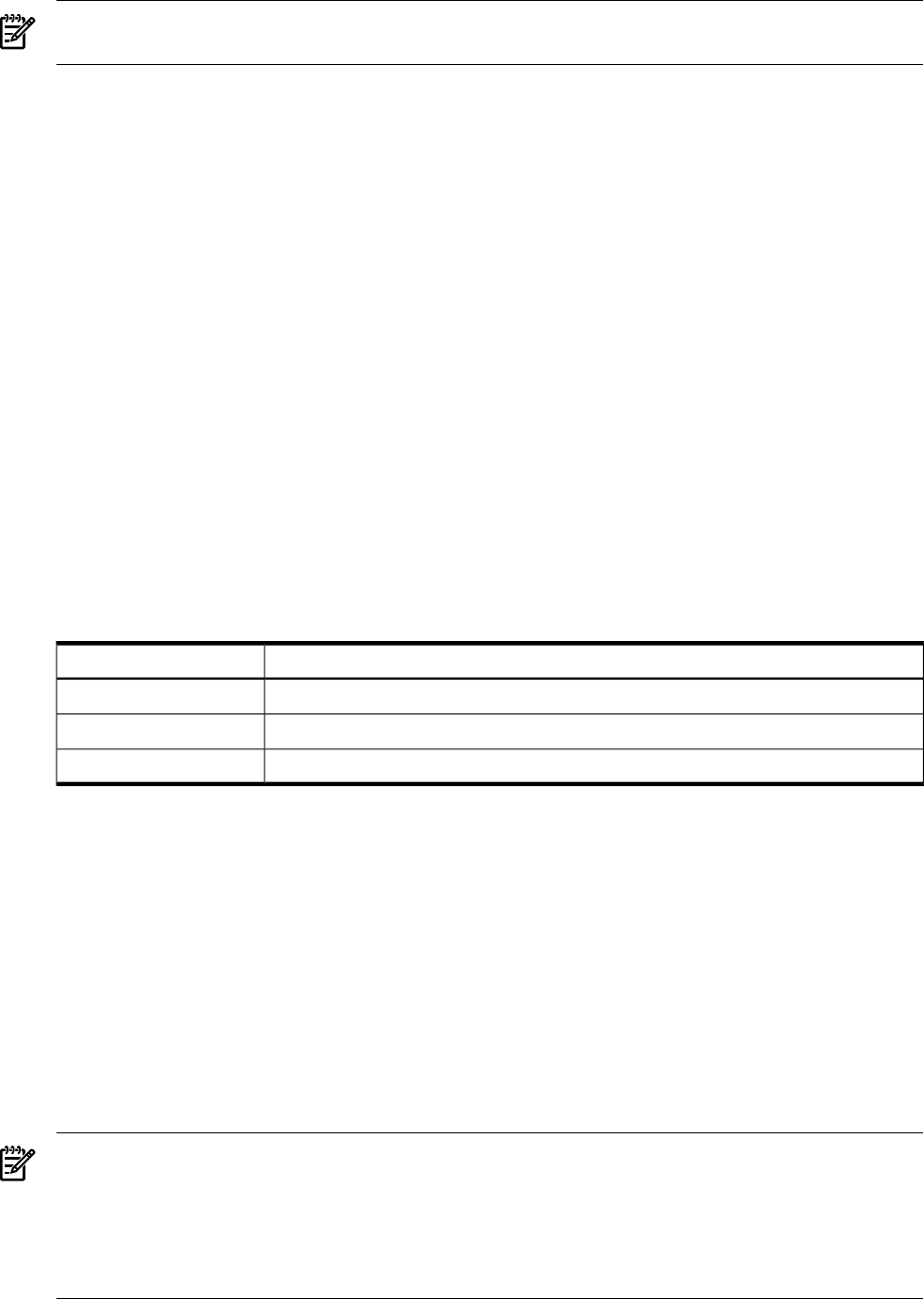User Service Guide, Third Edition - HP Integrity rx4640 Server
Table Of Contents
- HP Integrity rx4640 Server User Service Guide
- Table of Contents
- About This Document
- 1 Introduction
- 2 Controls, Ports, and LEDs
- 3 Powering Off and Powering On the Server
- 4 Removing and Replacing Components
- Safety Information
- Service Tools Required
- Accessing a Rack Mounted Server
- Accessing a Pedestal Mounted Server
- Removing and Replacing the Front Bezel
- Removing and Replacing the Front and Top Covers
- Removing and Replacing the Memory Extender Board
- Removing and Replacing Memory DIMMs
- Removing and Replacing the Processor Extender Board
- Removing and Replacing a Processor
- Removing and Replacing Hot-Swappable Chassis Fans
- Removing and Replacing the I/O Baseboard
- Removing and Replacing Hot-Pluggable PCI-X Cards
- Removing and Replacing OLX Dividers
- Removing and Replacing Core I/O Cards
- Removing and Replacing the Server Battery
- Removing and Replacing Hard Disk Drives
- Removing and Replacing the SCSI Backplane Board
- Removing and Replacing the Midplane Riser Board
- Removing and Replacing the Power Supplies
- Removing and Replacing the Power Distribution Board
- Removing and Replacing the DVD Drive
- Removing and Replacing the DVD I/O Board
- Removing and Replacing the Display Board
- Removing and Replacing the QuickFind Diagnostic Board
- 5 Troubleshooting
- Troubleshooting Tips
- Possible Problems
- Troubleshooting Using LED Indicators
- Diagnostics
- Recommended Cleaning Procedures
- Where to Get Help
- A Parts Information
- B Booting the Operating System
- Operating Systems Supported on HP Integrity Servers
- Configuring System Boot Options
- Booting and Shutting Down HP-UX
- Booting and Shutting Down HP OpenVMS
- Booting and Shutting Down Microsoft Windows
- Booting and Shutting Down Linux
- C Utilities
- Extensible Firmware Interface Boot Manager
- EFI/POSSE Commands
- Specifying SCSI Parameters
- Using the Boot Configuration Menu
- Index

NOTE: If you install a modem in your server, make sure you disable the modem serial port in
both the Active Console Input and Active Console Output device lists.
Some operating systems support multiple consoles, such as a simultaneous serial and VGA
output. To determine how many consoles are supported with your server, see your OS
documentation. Multiple consoles are not supported for HP-UX or Windows (use the Smart
Setup CD to switch between COM A and the iLO MP on Windows systems).
For example:
Select the Console Output Device(s)
Acpi(PNP0501,0)/Uart(9600 N81)/VenMsg(PcAnsi)
Acpi(PNP0501,0)/Uart(9600 N81)/VenMsg(Vt100)
* Acpi(PNP0501,0)/Uart(9600 N81)/VenMsg(Vt100+)
Acpi(PNP0501,0)/Uart(9600 N81)/VenMsg(VtUtf8)
Acpi(HWP0002,700)/Pci(1|1)/Uart(9600 N81)/VenMsg(PcAnsi)
Acpi(HWP0002,700)/Pci(1|1)/Uart(9600 N81)/VenMsg(Vt100)
* Acpi(HWP0002,700)/Pci(1|1)/Uart(9600 N81)/VenMsg(Vt100+)
Acpi(HWP0002,700)/Pci(1|1)/Uart(9600 N81)/VenMsg(VtUtf8)
* Acpi(HWP0002,700)/Pci(2|0)
* indicates a currently selected device.
This menu is identical to Console Error Devices. The HP Integrity rx4640 server does not support
different configurations for Output and Error console. For correct operation:
• When changes are made to either Output or Error console menus, the identical change must
be made in both menus.
• When changing serial devices, changes must be made to Output, Input, and Error menus
for proper operation.
Table C-3 Console Output Devices
Choose:To select:
Acpi(PNP0501,0)/Uart(9600 N81)/VenMsg(Vt100+)Serial A/Serial 1
Acpi(HWP0002,700)/Pci(1|0)/Uart(9600 N81)/VenMsg(Vt100+)iLO MP Serial Console
Acpi(HWP0002,700)/Pci(2|0)iLO MP VGA Port
• Each option is identified with an EFI device path. Not all options will be available, depending
on the configuration of the server and the options purchased. Device paths can differ slightly
on different product models.
• On both serial device examples, UART 9600 indicates the current baud rate of the serial
device (can be changed with the EFI shell baud command), VenMsg Vt100+ is the current
emulation type (several different terminal emulation protocols are supported, see list above).
• Only one terminal emulation type (PcAnsi, Vt100, etc.) can be selected for each serial console,
but multiple serial consoles can be selected at a time.
Console Configuration
To define the devices that display output from the system console, use this option. This list
normally includes the VGA monitor and a serial port for directing output to a terminal emulation
package.
NOTE: If you install a modem in your server, make sure you disable the modem serial port in
both the Active Console Input and Active Console Output device lists.
Some operating systems support multiple consoles, such as a simultaneous serial and VGA
output. To determine how many consoles are supported with your server, see your OS
documentation. Multiple consoles are not supported for HP-UX or Windows (use the Smart
Setup CD to switch between COM A and the iLO MP on Windows systems).
For example:
160 Utilities










